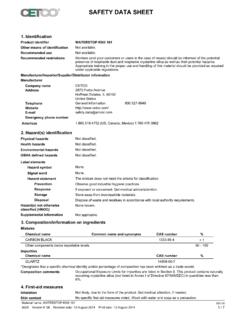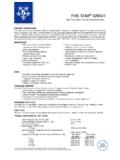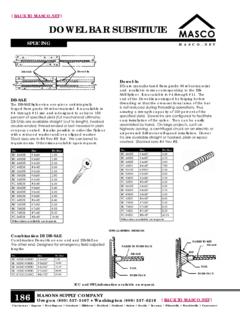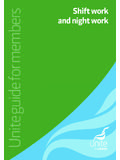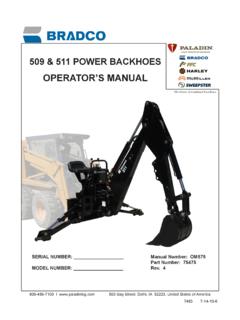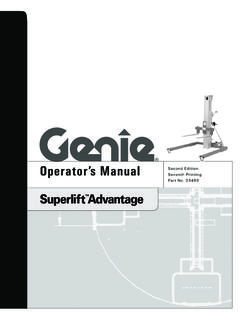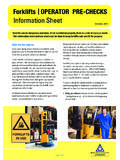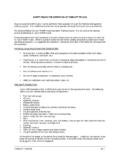Transcription of FORKLIFT OPERATOR Training - Masons Supply …
1 OREGON WASHINGTON 2637 SE 12th Avenue 6018 234th Street SE, Suite A Portland, OR 97202 Woodinville, WA 98072 (503) 234-4321 (425) 487-6161 - 1 - FORKLIFT OPERATOR SAFETY Training Introduction | Welcome to FORKLIFT Safety Training FORKLIFT operators are the movers and shakers of the industrial world. Without forklifts everyday tasks (in warehouses, factories, and construction sites) would take much longer. The FORKLIFT OPERATOR does important work, but that work isn t worth much if it isn t done safely. forklifts are powerful machines.
2 A carelessly driven FORKLIFT can injure or even kill. This course will provide you with the Training you need to do valuable work and do it safely. When you finish this Training and quiz, you should be able to complete the following tasks safely: Perform a pre-operation FORKLIFT inspection Drive a FORKLIFT Lift and place a load Work inside a truck, trailer, or rail car Park and leave a FORKLIFT Refuel a FORKLIFT You should also be able to explain the following concepts: How the FORKLIFT differs from other vehicles The basics of the stability triangle The special features of motorized hand trucks and high lift units The guidelines for conducting regular maintenance on the FORKLIFT The guidelines for recording FORKLIFT modifications ---------------------------------------- ---------------------------------------- ---------------------------------------- ---------- OREGON WASHINGTON 2637 SE 12th Avenue 6018 234th Street SE, Suite A Portland, OR 97202 Woodinville, WA 98072 (503) 234-4321 (425)
3 487-6161 - 2 - Section 1 | FORKLIFT Basics and Inspection There are different forklifts for different work environments, and for different kinds of lifting and moving tasks. The most common type of FORKLIFT has a heavy counterweight over the rear tires to balance the load. These lifts usually have solid rubber tires, and are common in factories and warehouses. If equipped with pneumatic tires, this kind of lift can be used out of doors. Other forklifts raise the OPERATOR with the forks, or are operated from a standing position. Hand lifts are operated while walking behind the lift sometimes they lift the load only a few inches off the ground. A FORKLIFT is any mechanical device, powered by an electric motor or internal combustion engine that is used to move or lift loads. Don t expect a FORKLIFT to handle like a car or truck. Because of the counterweight over its rear wheels, a FORKLIFT is much heavier than a car.
4 As a result, it can t stop or turn quickly. FORKLIFT steering is also different from automobile steering. Cars and trucks use their front wheels to steer. But a FORKLIFT uses its rear wheels, which allows it to turn in a very tight circle. But it means that the back end can swing out when turning. When turning a FORKLIFT , watch behind you to make sure the rear end of the lift doesn t run into anything or anyone. Also keep an eye out for your forks and any load you may be carrying. The rear end of the FORKLIFT swings in a circle around the front wheels. Make sure there s room for the rear end to swing out when making turns. And if you re moving a load in reverse, don t forget to allow room for the load to swing too. Most forklifts have a three-point suspension system. The three points are the two front wheels and the pivot point of the rear axle.
5 Connect the three points, and you have what s called the stability triangle. OREGON WASHINGTON 2637 SE 12th Avenue 6018 234th Street SE, Suite A Portland, OR 97202 Woodinville, WA 98072 (503) 234-4321 (425) 487-6161 - 3 - One major difference between a FORKLIFT and a car is stability. Almost all counterbalanced powered industrial trucks have a three-point suspension system. That is, the vehicle is supported at three points. This is true even if the vehicle has four wheels. The truck s steer axle is attached to the truck by a pivot pin at the axle s center.
6 When the points are connected with imaginary lines, this three-point support forms a triangle called the stability triangle. When at rest, on level ground, the FORKLIFT s center of gravity is within the stability triangle. But if the FORKLIFT is put in motion, or sits on a sloping surface, its center of gravity shifts. Any time the FORKLIFT s center of gravity moves outside the stability triangle, the lift will tip over. The FORKLIFT s center of gravity moves when you accelerate, brake, or turn. An unloaded FORKLIFT can also tip from the weight of the counterbalance, so safe driving is just ask important with an unloaded lift. Now you ve seen how a FORKLIFT s center of gravity can shift. It gets a lot more complicated when we add the weight of a load to the FORKLIFT , and raise that load in the air. This is because the center of gravity for a loaded life is actually the combined center of gravity for both the lift and the load.
7 The heavier the load and the higher you lift the further forward the combined center of gravity goes. Imagine a vertical line passing through the combined center of gravity. This line is called the line of action. If the bottom of this line goes outside of the stability triangle because a load is too heavy or too high, or because the FORKLIFT is not on a level surface it will tip over. A vertical line extending from the center of gravity of the vehicle-load combination must stay inside the stability triangle to prevent the FORKLIFT from tipping. FORKLIFT stability is based on keeping the center of gravity inside what s called the stability triangle. This stability triangle is made by connecting the two front wheels and the pivot point of the rear axle. The other concept to understand is the FORKLIFT s center of gravity. Notice that the front and rear edges of the stability triangle are high-lighted.
8 When unloaded, the FORKLIFT s center of gravity is right about here. When a load is added, the FORKLIFT s center of gravity moves towards the forks. Heavier loads shift the center of gravity forward even further. Raising the load also shifts the center of gravity forward. In order to prevent the lift from tipping, the combined center of gravity of the load and the lift must stay inside the stability triangle (at ground level) at all times. The same is true of side stability. If you have a balanced load, the load is unlikely to impact the side-to-side center of gravity. But if you drive on a sloped surface, your center of gravity could pass outside of the stability triangle and the lift could tip. Every FORKLIFT has an identification plate that lists important information about the truck. This plate will tell you the model and serial number of the truck, the weight of the truck, and its load capacity.
9 To be sure that the center of gravity of your FORKLIFT stays inside the stability triangle, don't try to lift anything heavier than the identification plate allows. No matter how busy you are, you must inspect your FORKLIFT before using it. If you do find something that could affect the safety of the vehicle you must report it immediately. Do OREGON WASHINGTON 2637 SE 12th Avenue 6018 234th Street SE, Suite A Portland, OR 97202 Woodinville, WA 98072 (503) 234-4321 (425) 487-6161 - 4 - not use the FORKLIFT until the problem is corrected. Follow the OPERATOR s manuals supplied by the equipment manufacturer.
10 These manuals describe the safe operation and maintenance of forklifts . Remember, the OPERATOR is responsible for the safe operation of the FORKLIFT . Do a pre-operation inspection before every shift. If the FORKLIFT is used around the clock, inspect it either before each shift or after each shift. The pre-operation inspection covers every aspect of the FORKLIFT . It is completed in two parts: the walk-around inspection, and, the seated inspection. OSHA does not require documentation of a daily inspection. But it's a good idea to have a checklist to make sure you don't miss any steps. These checklists can also be saved as a part of the maintenance record. Start with the walk-around inspection. Check the condition of the tires. If the FORKLIFT is an outdoor FORKLIFT with pneumatic tires, check the air pressure and look for excessive wear on the tires. A tire with low air pressure could cause the lift to tip when a load is raised.
